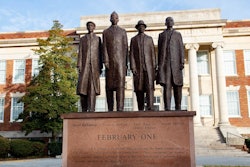Schools and school practices are integral to racial reconciliation and justice in the U.S., according to a new report that was published as part of UCLA’s Civil Rights Project. Dr. Liane I. Hypolite
Dr. Liane I. Hypolite
In the report titled, "The Racial Reckoning and the Role of Schooling: Exploring the Potential of Integrated Classrooms and Liberatory Pedagogies," the authors cite existing research to describe the ways in which schools, classrooms, and teaching strategies can be used to further racial equality and anti-racism.
After the 2020 police murder of George Floyd and the protests and “racial reckoning” against police violence that followed, various industries and sectors have had to reassess – or were said to be due for reassessments of – their own conditions and hierarchies, the report authors wrote.
However, subsequent white, conservative responses to these reckonings – such as attacks against Critical Race Theory – instead resulted in a perpetuation of racially inequitable and unjust conditions, the report noted. U.S. school systems have faced similar movements and tensions, with opposing efforts from leaders and stakeholders seeking to promote or silence the teaching of matters related to race.
“Any reckoning that began with George Floyd’s death in 2020, has itself been reckoned with, constraining many of the policies and practices that sought to undermine racial inequality in the United States,” the report noted.
Despite the outcome of the 1954 landmark case of Brown v. Board of Education and the resulting progress towards integration, racial segregation in schools persists. Research has shown that racial segregation increased during the 1990s, mostly because of rising segregation between school districts.
U.S. society never really got to the point of true integration and is now backsliding into resegregation, said report co-author Dr. Liane Hypolite, an assistant professor of educational leadership at Cal Poly Pomona.
Factors such as white flight, parental objections, standardized testing, more schooling options, and the drawing of district boundaries add to the resegregation of schools, according to the report. This all has led to the widening segregation of Black students and to white and Latinx students being the most segregated groups in U.S. schools.
“Any attempts at widespread reform will inevitably endure systemic racism,” the report noted. “The preferences of parents with power can reinforce segregation. When presented with opportunities to attend diverse schools, White parents often choose segregated options, and schools with more choice tend to be among the most segregated in the U.S.
Diverse schools that attempt to racially integrate their classrooms, the report pointed out, "often meet resistance from white, middleclass parents.”
Though these factors make integration in schools that much more difficult, accomplishing it would still come with its own slate of benefits, such as a reduction in racial bias, more interracial relationships, and increased support for affirmative action policies, the report authors wrote.
Still, school integration is not a be-all, end-all solution, given that even in integrated schools, racial hierarchies and social isolation can solidify. Institutional “racial tracking,” which puts students in different courses “based upon perceived academic abilities, indicators of achievement, and teacher subjectivities,” often sorts students by race, further exacerbating racial divides.
"We are still seeing segregation even within those schools by the kinds of practices that happen through putting particular students into high-level classes, like AP and honors, and some of those practices that are not necessarily written that they're going to racially segregate our students into different spaces but ultimately that's the impact that they have," Hypolite said.
The ways that schools teach students in classrooms can also worsen racial hierarchies and thus should be examined, the report noted.
“Our pedagogies and curricula themselves can be segregationist,” the report authors wrote. “Pedagogies and curricula that are welcoming for white students and exclusionary for students of color can reproduce the experience of segregation even when students are in the same classroom.”
According to research, potential ways to disrupt this segregation include having white students in classes that overtly discuss race and racism; stressing that group tasks require input from all participants; and being mindful of status hierarchies and students’ race, class, perceptions of intelligence, and personality traits.
"You used to do group work in your high school, right? And there's always kind of: 'Oh, I got that kid. He can't do anything. I'm going to do all the work because I know what I'm doing. He doesn't know anything,'” said report co-author Dr. Suneal Kolluri, an assistant professor in UC Riverside’s educational policy and leadership department. “But how do we reframe that so that all kids feel like everybody in their classroom is intelligent?
“Because, to be honest, everybody is, in their own way. But how do we access different kids' intelligences and elevate different visions of 'smart' to ensure that everybody feels connected to the classroom?"
The report also describes the various policy efforts that show promise in desegregating schools. One listed was the removal of advanced coursework so that all students mainly go through the same courses and classrooms.
The report’s other co-authors are Dr. Alexis Patterson Williams, chair of teacher education at UC Davis, and Kimberly Young, social science department co-chair at Culver City High School.





















